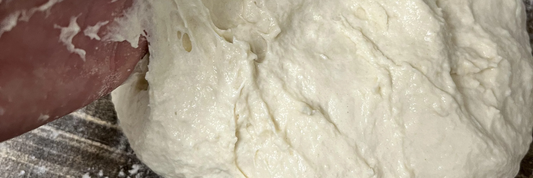Picture this: it's Friday night, you're craving homemade pizza, but the thought of making dough from scratch feels overwhelming after a long week. This scenario is all too common and it’s exactly why learning how to freeze pizza dough can transform your cooking routine.
After more than a decade of making pizza at home, I discovered that freezing pizza dough was the ultimate kitchen hack. Not only does it save time on busy nights, but it also lets you prepare dough in batches when you’re in the mood to cook. The secret to success lies in knowing how to freeze pizza dough the right way, preserving its texture, rise, and flavor for when you're ready to bake.
- What's the Best Beer with Pizza? An Expert Pairing Guide
- Who Invented Pizza? A Complete History of the World’s Favorite Dish
Best Time to Freeze Pizza Dough
Can You Freeze Pizza Dough After It Rises
The optimal moment to freeze pizza dough is immediately after its first rise, also known as bulk fermentation. During this stage, the yeast has done its primary job of developing flavor compounds and creating the initial structure. The gluten network has formed properly, giving the dough its characteristic elasticity and strength.
From my experience, dough frozen at this stage maintains the best texture after thawing. The fermentation process has already begun, which means you're capturing all those complex flavors that develop during the first rise. I've found that dough frozen too early - before any fermentation - often results in a flatter, less flavorful final product.
The science supports this timing as well. Research shows that yeast cells are most resilient to freezing temperatures when they're in an active but not exhausted state, which occurs right after bulk fermentation.

Before Final Proofing
Another excellent time to freeze pizza dough is before the final proofing stage. This approach offers several practical advantages that make it my preferred method for most home bakers.
When you freeze dough before final proofing, it becomes significantly easier to shape after thawing. The cold temperature firms up the gluten structure, making the dough less sticky and more manageable. I've noticed that frozen-then-thawed dough often stretches more easily than fresh dough, which is particularly helpful when you're aiming for those thin, crispy crusts.
This timing also preserves yeast viability exceptionally well. The yeast cells haven't been stressed by a second fermentation cycle, so they retain more energy for the final rise after thawing. In practical terms, this means your thawed dough will still puff up beautifully in the oven.
How to Freeze Pizza Dough
Portion and Shape
Before freezing, divide your dough into individual pizza-sized portions. I typically make balls that weigh between 8-12 ounces, which creates perfect personal-sized pizzas or medium crusts for sharing.
The shape matters more than you might think. Round balls take up less freezer space than irregular chunks, and they thaw more evenly due to their uniform thickness. Some bakers prefer flattening the dough into discs, which can speed up thawing time, but I find balls maintain better texture.
Consider your typical pizza-making habits when portioning. If you usually make two pizzas at once, freeze the dough in pairs. If you prefer individual pizzas for meal prep, portion accordingly. This advance planning saves time and reduces waste.

Pre-Freezing Step
Here's a step that many home bakers skip, but it makes a significant difference in the final product quality. Place your shaped dough balls on a parchment-lined tray and freeze them for about one hour until they're firm to the touch.
This pre-freezing step prevents the dough balls from sticking together and maintains their shape during long-term storage. Without this step, you might find your carefully portioned dough has merged into an unwieldy mass that's difficult to separate.
I learned this technique from a professional baker who emphasized that proper texture depends on how ice crystals form in the dough. Quick, initial freezing creates smaller ice crystals that cause less damage to the gluten structure.
Wrap Securely
Proper wrapping is crucial for maintaining dough quality during freezer storage. I wrap each dough ball individually with plastic wrap, pulling it tight against the surface to eliminate air pockets. The goal is to create a "second skin" that prevents freezer burn and moisture loss.
After the plastic wrap, place each wrapped ball in a freezer bag or airtight container. Double-wrapping might seem excessive, but it's insurance against the dry freezer environment that can turn your dough into a tough, unusable mass.
Some bakers use vacuum-sealed bags, which work excellently but aren't necessary for most home situations. The key is minimizing air exposure, which causes oxidation and affects both flavor and texture.
Label & Store
Never underestimate the importance of proper labeling. I write the date and dough type on each package using a permanent marker. Trust me, three months later, you won't remember whether that mysterious frozen ball is pizza dough or bread dough.
Store the wrapped dough in the coldest part of your freezer, typically the back section away from the door. Temperature fluctuations near the door can create ice crystals and degrade quality over time.
For optimal quality, use frozen pizza dough within three months. While it remains safe to eat beyond this timeframe, the texture and rise quality begin to decline noticeably after the three-month mark.
How to Thaw Frozen Pizza Dough
Refrigerator Thaw (8–24 Hours)
The refrigerator method is my preferred thawing technique for the best possible results. Transfer your frozen dough to the refrigerator 8-24 hours before you plan to use it, depending on the size of your dough portions.
This slow thawing process allows the dough to undergo a gentle second rise while defrosting. The extended time in the refrigerator actually improves flavor development, as the yeast slowly becomes active again and continues fermenting at a controlled pace.
I've noticed that refrigerator-thawed dough has superior flavor compared to quickly thawed versions. The slow process allows gluten strands to relax and reorganize, resulting in dough that's easier to stretch and shape.

Room-Temperature Thaw (2–4 Hours)
When you need pizza sooner than the refrigerator method allows, room-temperature thawing is your next best option. Remove the dough from the freezer and let it sit at room temperature for 2-4 hours, depending on ambient temperature and dough size.
Cover the thawing dough with a damp towel to prevent the surface from drying out and forming a skin. This covering also helps maintain the proper moisture level for optimal yeast reactivation.
Monitor the dough closely during room-temperature thawing. You'll know it's ready when it feels pliable and has roughly doubled in size from its frozen state.
Warm Water Bath (30–60 Minutes)
For accelerated thawing, place your wrapped dough in a sealed plastic bag and submerge it in warm (not hot) water. This method typically takes 30-60 minutes and works well when you're in a time crunch.
Keep the water temperature around 70-80°F to avoid shocking the yeast or accidentally starting to cook the dough. Change the water every 15 minutes to maintain consistent temperature.
Be cautious not to overheat the dough, as temperatures above 85°F can damage yeast cells and affect the final rise quality.
Microwave Defrost (5–10 Minutes)
The microwave represents the fastest thawing option, though it requires careful attention to avoid partially cooking the dough. Use your microwave's defrost setting for 5-10 minutes, checking every 2-3 minutes.
After microwaving, let the dough rest at room temperature for at least 30 minutes to allow the yeast to reactivate properly. The microwave method works best for urgent situations, but I don't recommend it as a regular practice.
Some areas of the dough may warm faster than others, so gently knead the thawed dough to redistribute temperature and moisture evenly.
Baking from Frozen (Par-Bake Method)
An alternative approach involves par-baking pizza crusts before freezing. Roll out your fresh dough, partially bake it for 5-7 minutes at 450°F, then cool completely before freezing.
This method allows you to go directly from freezer to fully topped pizza in about 15 minutes. The partially baked crust maintains structure while still allowing for final browning and crisping.
When ready to eat, top the frozen par-baked crust and finish baking at high temperature (475-500°F) for 8-12 minutes until cheese is bubbly and crust is golden.
Impact of Freezing on Dough Quality
Yeast Dormancy & Gluten
Understanding what happens to your dough during freezing helps you set realistic expectations and work with the changed product effectively. Freezing doesn't kill yeast - it simply makes it dormant. Think of it as putting the yeast to sleep rather than eliminating it entirely.
The gluten network, which gives pizza dough its stretch and chew, remains largely intact during proper freezing. However, the gluten proteins do undergo some changes that can actually benefit certain pizza styles.
I've observed that frozen-then-thawed dough often handles more easily than fresh dough, particularly when rolling thin-crust pizzas. The gluten seems more relaxed and less likely to snap back during shaping.

Depolymerization
During freezing, some gluten breakdown occurs through a process called depolymerization. While this might sound concerning, it actually makes the dough easier to stretch and shape without tearing.
This partial gluten breakdown explains why many pizzaiolos actually prefer working with day-old or previously frozen dough for certain applications. The dough becomes more extensible while retaining enough strength for proper structure.
The key is understanding that this change is gradual and most pronounced in the first month of freezing. Beyond that timeframe, continued breakdown can negatively impact texture.
Potential Drawbacks
Ice crystal formation represents the primary threat to frozen dough quality. Over time, these crystals can puncture cell walls and gluten strands, leading to a weaker, less elastic dough.
Proper wrapping and consistent freezer temperatures minimize ice crystal damage, but some degradation is inevitable with extended storage. This is why I recommend using frozen dough within 1-3 months for optimal results.
Flavor can also diminish over time, though this happens more slowly than texture changes. The complex compounds that give fermented dough its characteristic taste gradually break down during frozen storage.
FAQs: Can You Freeze Pizza Dough
Can you freeze pizza dough?
Absolutely, and it's one of the best make-ahead techniques for home pizza makers. Pizza dough freezes exceptionally well when handled properly, maintaining most of its original texture and flavor for up to three months.
The key to successful freezing lies in timing - freeze after the first rise but before final proofing - and proper wrapping to prevent freezer burn. I've been freezing pizza dough for years with consistently excellent results.
How long can you freeze pizza dough?
Pizza dough maintains peak quality for up to three months in the freezer when properly wrapped and stored at 0°F or below. While it remains safe to eat beyond this timeframe, you may notice decreased rise and altered texture.
I've used dough that was frozen for six months, and while it was still edible, the texture was noticeably different - less chewy and more dense than fresh dough.
Do you freeze before or after rising?
Freeze pizza dough after the first rise (bulk fermentation) but before the final proofing stage. This timing preserves yeast viability while maintaining proper gluten development.
Freezing before any rise results in less flavorful dough, while freezing after final proofing can lead to over-fermentation issues during thawing.
Can sourdough pizza dough be frozen?
Yes, sourdough pizza dough freezes well using the same techniques as commercial yeast dough. The natural acids in sourdough actually provide some protection against freezer damage.
I find that sourdough pizza dough maintains its tangy flavor particularly well through freezing, sometimes even developing more complexity during the thawing process.
Can you bake pizza dough from frozen?
While possible, baking directly from frozen isn't ideal for raw dough. The outside cooks faster than the interior, often resulting in uneven texture.
However, par-baked crusts can go directly from freezer to oven with excellent results. This method combines the convenience of freezing with the quality of fresh-baked pizza.
Why did my frozen pizza dough not rise?
Several factors can prevent frozen dough from rising properly after thawing. The most common cause is yeast death due to temperature shock - either from freezing dough that was too warm or thawing it too quickly.
Improper storage can also damage yeast cells over time. Freezer burn, caused by inadequate wrapping, creates dry conditions that stress and eventually kill yeast.
Sometimes the issue is simply patience. Frozen dough takes longer to rise than fresh dough, especially if thawed in the refrigerator. Give it extra time, and you'll often see the rise you're expecting.
Conclusion
Mastering the art of freezing pizza dough opens up a world of convenient, homemade pizza possibilities. With proper technique and timing, you can maintain bakery-quality results while saving significant time on busy weeknights. The investment in learning these methods pays dividends in both convenience and consistently delicious homemade pizza.







